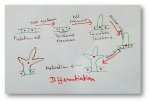Safety at Home
We should follow the safety at home in the kitchen, in the bathroom and around the house.
1. Safety rules in the kitchen:
Fire, electricity and sharp knives are used in the kitchen. We have to be very careful with these things as these things can cause dangerous accidents.
(i) Never play with knives and other sharp tools. We need to learn how to use a knife properly. Always use it in the presence of an adult.
(ii) We should not go into the kitchen wearing nylon clothes. They catch fire easily. Keep away from the stove when food is being cooked. Matchsticks can be very dangerous we should not play with them and should use them properly in the presence of an adult.
(iii) Never climb on a chair or a table to reach things from
the shelves we should always use a step ladder.
(iv) We should not play with glass things because they break easily and hurt badly. If glass things break do not try to pick the broken pieces with our hand. We should take the help of an adult to clean.
(v) If we spill something on the floor we should wipe the floor immediately. Anyone can slip and fall on a wet floor.
(vi) We should not use electric gadgets on our own. Electric gadgets, wires, plugs and sockets can give us dangerous shocks if we be careless while using them.
2. Safety rules in the bathroom:
We have to be very careful because the main dangers in the bathroom are from slipping on the wet floor and from electric gadgets in the bathroom such as water heaters or geysers.
(i) We should use a rubber mat or bathmats in the shower to keep ourself safe from slipping.
(ii) We should never touch an electric switch with wet hands or while standing bare foot on a wet floor.
3. Safety rules around the house:
(i) Never eat any medicine unless doctors prescribe us.
(ii) We should not eat stale food because it can cause food poisoning.
(iii) We should not run on the staircase because if we fall on the staircase it can be dangerous accident. We can break our bones.
(iv) We should not leave our toys or other things lying around on the floor. Anyone can trip over those things and get hurt.
From Safety at Home to HOME PAGE
Recent Articles
-
Differentiation, Dedifferentiation and Redifferentiation | Definition
Apr 21, 25 01:16 PM
Cells from the root apical meristem and shoot apical meristem the camera that differentiate , mature to perform different functions. This process by which the cells undergo different major structural… -
Explain about Growth in Plants |Definition of Growth & Differentiation
Feb 27, 25 02:07 PM
Growth is a permanent increase in length or volume of an organism that brought upon by an increase in its dimensions due to synthesis of new protoplasmic material. -
Definition of Respiratory Quotient | calculation | Application | Plant
Dec 02, 24 12:09 AM
Definition of respiration quotient- the ratio of the carbon-dioxide evolved to that of the oxygen consumed by a cell, tissue, plants or animals in a given time is called respiratory quotient. It is us… -
Amphibolic Pathway | Definition | Examples | Pentose Phosphate Pathway
Jun 06, 24 10:40 AM
Definition of amphibolic pathway- Amphibolic pathway is a biochemical pathway where anabolism and catabolism are both combined together. Examples of amphibolic pathway- there are different biochemical… -
Respiratory Balance Sheet | TCA Cycle | ATP Consumption Process
Feb 18, 24 01:56 PM
The major component that produced during the photosynthesis is Glucose which is further metabolised by the different metabolic pathways like glycolysis, Krebs cycle, TCA cycle and produces energy whic…




New! Comments
Have your say about what you just read! Leave me a comment in the box below.